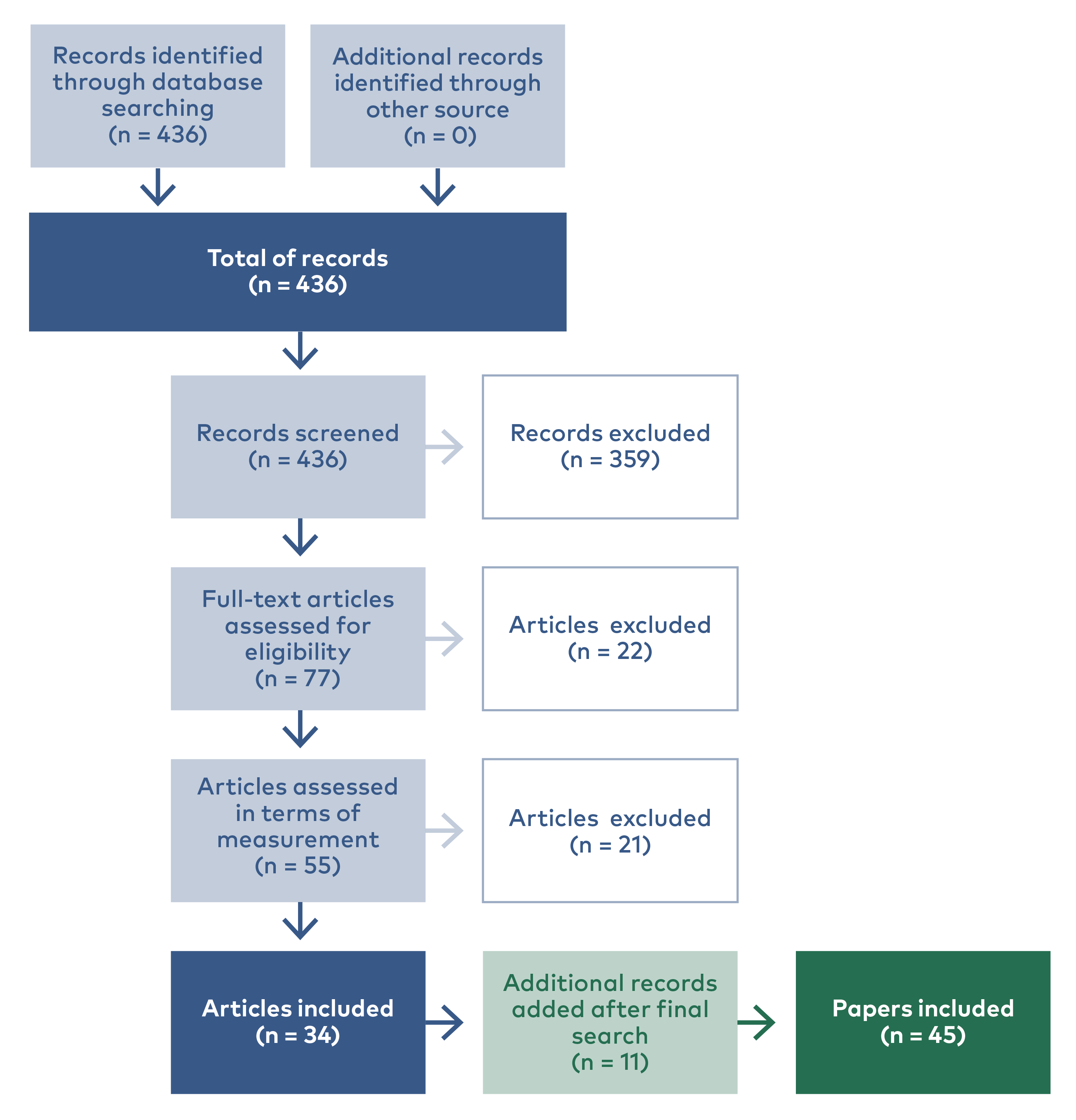Methods
This study is a literature review of empirical studies on the social impact of COVID-19 on Nordic residents. The research search was conducted between April 11 and September 22, 2022. In total 45 studies were used for the study.
Literature review
The literature review is based on a search of Web of Science, a global citation database which gives access to multiple electronic databases. The initial search was conducted between April 11 and April 19, 2022. Articles had to fulfil the following inclusion criteria: (1) focus on the current COVID-19 pandemic, (2) report on experiences of loneliness and/or social isolation as an outcome of the pandemic, and (3) study participants should come from the Nordic countries. This could involve participants from other countries, too. Taken as a whole, the studies cover the entire population except children, refugees, and immigrants, who are included in other NWC projects. We searched the database using the keywords ‘COVID-19’ (or coronavirus, or corona pandemic, or SARS-CoV-2) and ‘social isolation’ or ‘loneliness’. The search was then refined by the Nordic countries.
This initial search resulted in a total of 436 records. Those that did not meet our inclusion criteria were excluded after screening the abstract, and the remaining full-text articles (n=77) were then screened for eligibility. Literature reviews, commentaries, and studies that did not measure loneliness or social isolation were removed (n=22). We also excluded articles (n=21) that treated loneliness or social isolation as predictors of other indicators of well-being or which combined loneliness or social isolation with such indicators.
On July 22, we checked the WHO Global research database for any additional papers but there were no other publications relevant for this report. On September 21, 2022, the draft report and selection of studies was discussed in the project’s reference group of Nordic researchers studying loneliness and social isolation. As a result, two reports with information on older Swedish people were added. We did a final search of Web of Science with the same keywords on September 22 to include relevant studies published after our initial search and found 11 more studies. In total, 45 studies provided information for answering the research questions (Figure 1).
Figure 1. Flowchart of the selection of literature for the report

Limitations in the selected studies
Before discussing the studies and answering the research questions, we stress that the studies included in this report were not designed to answer our research questions. This resulted in several limitations. The perfect study to answer our research questions would include all Nordic countries, have representative samples of all subgroups, and follow the same people before and during the whole pandemic. Such studies do not exist. Most studies were conducted during the first wave, while a limited number (also) included data until the end of the second lockdown (March–May 2021). Our findings thus emerge mainly from the first one or two lockdowns of the pandemic. Many studies were cross-sectional, that is, a study at a specific point in time. This does not allow for conclusions on changes in loneliness from before or during the pandemic. Study samples were not always representative for the population under study, as healthier, higher educated people, and women are often overrepresented, while the loneliest, the oldest-old, and the most isolated people may be underrepresented. Many studies collected the data online, which is a reasonable method given the social distancing regulations, but it excludes people who have no access to internet or lack the skills to use it (most often the oldest-old).
A positive exception was the study of Pedersen and others (2022), where many of the limitations did not apply. In this study, data were collected from a large sample of Danish people aged 18 years and over in Denmark during the first 16 months of the pandemic. From March 2020 until July 22, 2021, data were collected at 43 points in time, and at each of these points a sample of individuals 18 years and over were asked to fill in an online questionnaire. The data of each survey was weighted to account for age, gender, and the regional composition of Denmark. This weighting and unique data collection enabled researchers to estimate precise developments in loneliness and social isolation (among others) during the first two waves. They further investigated differences between men and women, younger middle-aged and older adults, and people who had previously self-reported a diagnosed chronic and/or mental illness.